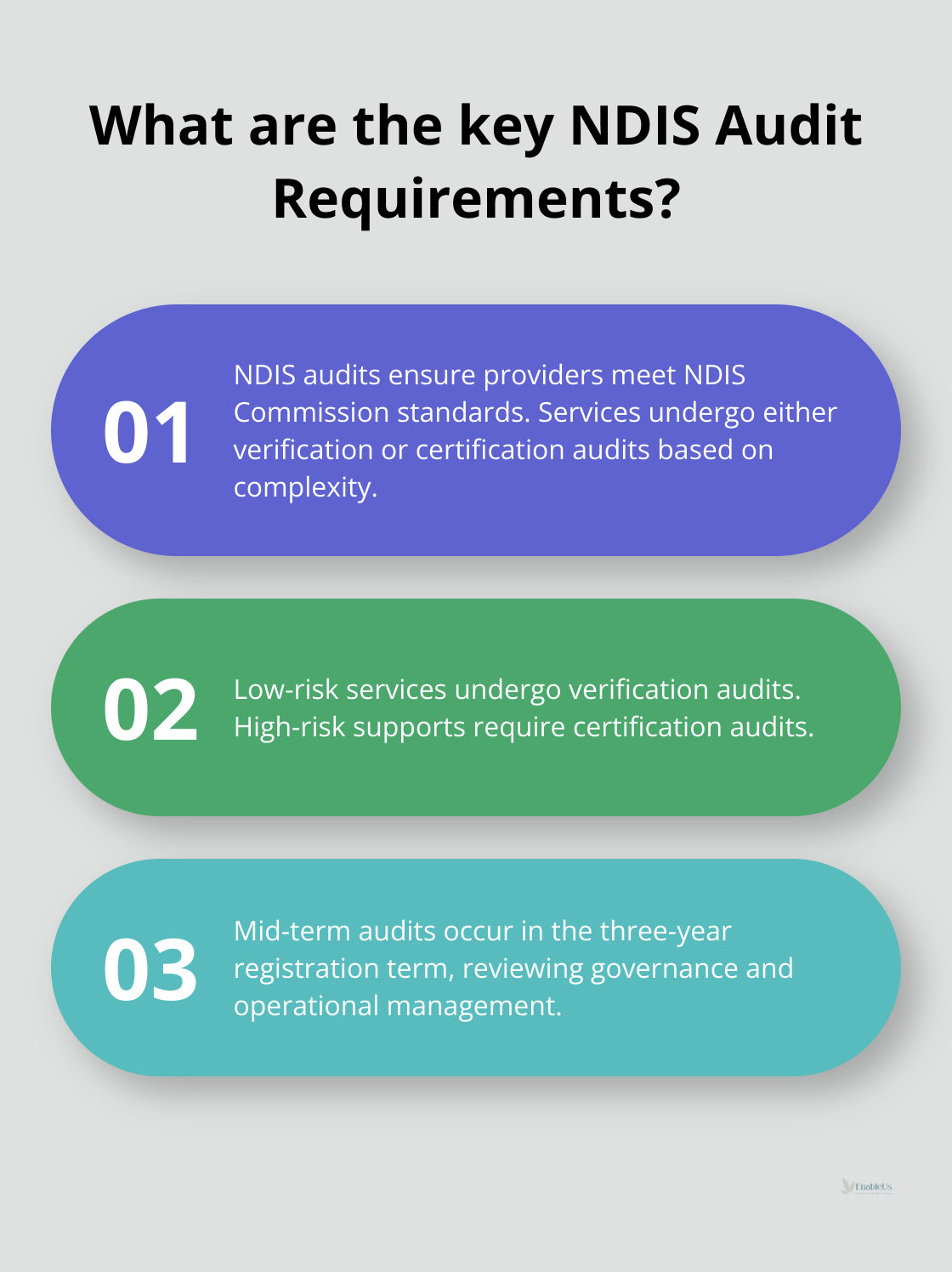Navigating the National Disability Insurance Scheme (NDIS) provider audit process can feel… well, like trying to do calculus while riding a unicycle. But it doesn’t have to be.
At EnableUs, we aim to demystify (fancy word for simplify) the key aspects of NDIS audits and toss in some practical tips to ensure you sail through this process.
Follow our guide, and you’ll be better prepared—boosting your compliance and leveraging audit results to drive continuous improvement.
What Are NDIS Provider Audits?
First off, let’s demystify NDIS provider audits. They’re critical for anyone serious about proper registration and staying compliant. In simpler terms: you gotta get this right if you want your NDIS gig to keep rolling. Here’s the lowdown on what these audits entail and how to ace your documentation game.
Overview of NDIS Audit Requirements
So, NDIS provider audits — what’s the deal? Basically, they ensure you’re hitting the marks set by the NDIS Commission. Services undergo either a verification or certification audit, depending on their complexity. Low-risk? You’re looking at verification. Playing with the big kids (high-risk supports)? You’re up for certification.

Mid-term audits? They pop up for providers with three-year registration terms, dissecting governance, operational management, and necessary tweaks. Costs? They’re all over the map, running anywhere from $500 to $10,000, based on your risk and service breadth.
Key Areas of Focus in Audits
Auditors — they’re not just checking boxes. They’re diving into the meat and potatoes of your operations.
- Qualifications and Training: Your team needs the right badges and continuous training. Not optional; a must. Show ’em you’re not just meeting standards but living them.
- Incident Management: Got a solid system for handling incidents? Prove it. How do you report, investigate, and resolve stuff when it goes sideways? Regular updates — not once and done.
- Complaints Handling: Clear, accessible, proactive. These aren’t just checklists; they’re trust builders with your participants. Show the auditors a feedback loop that’s alive and kicking.
- Risk Management: Bring a rock-solid risk assessment and management plan. How do you spot, assess, and snuff out risks? Auditors want to see you’re on the ball here.
Preparing Documentation and Records
Documentation — it’s your best friend and worst enemy. Start early and aim to be clean and organized.
- Policies and Procedures: Up-to-date and reflecting the real world. Cover essentials like safeguarding, health and safety, and participant engagement. No fairy tales.
- Staff Records: Keep them current — qualifications, training, background checks, performance reviews. Compliance 101.
- Incident and Complaint Records: Detailed logs. What happened, how you fixed it, and what you learned. Preventive measures? Show that you’re not making the same mistakes twice.
- Risk Assessments: Regular updates, real examples. Show you’re on top of identifying and managing risks.
Remember, your documents aren’t just for passing audits. They’re a statement of your commitment to top-quality services. Well-prepared records mean smoother audits. Simple as that.
For more in-depth tips, take a look at navigating the NDIS audit process.
Next up, let’s tackle how to turn audit results into continuous improvement gold and boost your service quality through the roof.
Practical Tips for a Successful NDIS Audit
Conduct Internal Audits Regularly
Regular internal audits—yeah, they’re not just a nice-to-have. Perform them at least twice a year. Why? Because when the external auditors come knocking, you want to be ready. Organizations that conduct internal audits semi-annually? They cut their risk of non-compliance by 25%. Focus on incident management, complaints handling, and risk assessments. Be proactive—address discrepancies way before the official audit. It’s like flossing. Pain in the neck? Yes. Worth it? Absolutely.
Implement Robust Compliance Systems
Robust compliance systems—you can’t skip this. It’s as essential as oxygen. Opt for software that tracks documentation, training, and incident reports in real time. These systems can reduce errors by up to 40%. Your compliance system should integrate seamlessly with daily operations, making documentation a breeze during audits. Consistent updates and advancements? They keep your organization aligned with the latest NDIS standards—minimizing compliance risks. Think of it as your trusty sidekick in the compliance game.
Train Staff Thoroughly on NDIS Standards
Training isn’t a one-and-done affair—it’s a continuous necessity. Organizations with ongoing training programs see 30% fewer critical incidents. Push NDIS standards in training modules and toss in practical scenarios to reinforce learning. Regular refresher courses plus practical assessments ensure staff not only get the NDIS guidelines but can apply them. Training—make it comprehensive, make it continuous. Don’t skip leg day, and definitely don’t skip training.

For an extensive guide on preparing for NDIS audits, check out our comprehensive guide and stay ahead of audit challenges.
How Can Audit Results Drive Improvement?
Turning audit results from a chore into a game-changer. Here’s your cheat sheet to maximizing the value they bring to your organization.
Analyzing Audit Feedback
First things first—parse through the audit feedback like a detective on his magnum opus. Don’t merely skim… do a deep dive. Spot recurring themes and areas marked for improvement. Focus on non-conformities (the Achilles’ heel). These are your golden tickets to instant wins. Fun fact: a study found that 68% of organizations saw serious compliance improvements when they tackled non-conformities head-on.

Assemble your dream team—a task force that brings diverse viewpoints. Different lenses can turn bland insights into spicy, actionable steps. Dissect each feedback nugget and delegate. Bake these tasks into your daily grind to ensure continuous improvement isn’t just a buzzword. Reflect, iterate, based on cold, hard facts.
Developing a Continuous Improvement Plan
Turn feedback into your secret weapon. Develop a Continuous Improvement Plan (CIP) rooted in the audit’s revelations. Your CIP should be as detailed as a NASA mission plan—specific actions, timelines, and who does what. Data from the NDIS Quality and Safeguards Commission? They say organisations with a robust CIP see up to a 50% boost in compliance and participant satisfaction.
Keep your CIP a living, breathing document. Update it with fresh insights and new regulations. Embed a feedback loop to gauge the effectiveness of your moves. Regular check-ins and progress checks turn plans from paper to reality. This isn’t just about checking boxes; it’s about fostering a culture of excellence and accountability.
Leveraging Technology for Better Compliance
The right tech? It’s your best friend here… Invest in integrated audit management software to keep your documents, training, and incident reporting on point. Tools like iAuditor can boost documentation accuracy by 30%, slashing admin load and response times to hiccups.
Automated alerts and updates? Keep your squad in the loop with compliance needs. Digital dashboards—think visual report cards—make spotting compliance trends or red flags a breeze. Roll in AI-based tools for risk assessment and you’re talking next-level compliance, nipping issues in the bud before they bloom.
For providers in rural areas, that tech lifeline is even more critical. It ensures smooth communication and compliance, erasing geographic hurdles. Want more on tackling regional challenges? See NDIS rural registration.
Audit results aren’t just mile markers—they’re fuel for ongoing progress. Use them smartly to take your service and compliance game to new heights.
Next up are strategies to weave those audit results seamlessly into your daily op routine.
Wrapping Up
Let’s boil it down—key audit tips: start with crystal-clear documentation and record management. Regular internal audits? Crucial. You outpace external reviews. Implement a compliance system that’s tighter than a drum and keep your team on a steady NDIS standard diet. This isn’t just prep for audits; it’s about baking excellence and accountability into your organisation’s DNA.

Why bother with regular audits? Well, they’re a goldmine. Spot compliance issues before they snowball, build rock-solid trust with participants, and pump up your service quality. Those who audit themselves—and actually use the feedback—see big wins in compliance and participant satisfaction.
Being proactive? Non-negotiable. Commit to ironclad documentation, continuous staff training, and leveraging the right tools to streamline compliance. Your organisation stays audit-ready, cuts down on risks, and nails smooth service delivery.
EnableUs is your go-to guru for NDIS registration. We don’t just talk the talk—we’ve walked over 2,500 successful applications. Tailored documentation, all-around support, and a seamless, affordable journey. Want to make your registration painless? Hit up EnableUs.
For deeper dives, check out our guide on NDIS audits. Stay ahead, be proactive, and let audits supercharge your NDIS services!
















